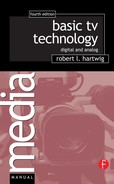Keys are “holes” that need to be filled.
Special Effects Keys — Luminance Keys
Keys are among the most common and useful special effects. Keys are essentially holes cut into a video picture that are filled with material from another source. Different types of keys rely on different information to determine the shape and nature of the holes and how they are filled. Luminance keys are triggered by differences in brightness (contrast). The hole in the original video is cut according to contrast differences supplied by a programmed source. The pattern the system derives from this source is called the key source or key signal. The figure at the right shows a common use of luminance keys.
Camera 2 is providing the key source — the bright star against the black background. The switcher receives the signal from camera 2 and reads the star as a pattern, the key source, based on the difference in brightness between the star and the background.The system cuts a hole in the shape of a star in the camera 1 video.
The hole can be filled in one of several ways. If the pattern that cuts the hole also fills the hole, it is a self-fill key. If the hole is filled by artificially created color from within the switcher itself, it is called a matte key. The hole can also be filled with a third source — video from a third camera, for example.
The greater the key source contrast between the desired pattern and its background, the more easily the key operates. White on black is ideal, but for key sources that don't have as much contrast, there will always be a “clip” adjustment that will allow you to compensate. Keys don't have to be geometric patterns. They can be (and often are) white lettering on a black background—titles, for instance. You certainly can key in other shapes, such as a white horse running against a dark background.
Linear or Transparent Keys
The type of key we have been discussing where the key is punched completely through the video is also called a nonlinear key. A linear or transparent key allows you to lay a key over the video without punching all of the way through it. This will allow the audience to see through the key to what is going on behind it. This is especially useful for sporting events where a nonlinear key could block the action caused by a sudden change on the field.
The most common use of the luminance key is for adding titles to video — for example, the names of the announcers which appear in the bottom third of the screen.
Luminance key

